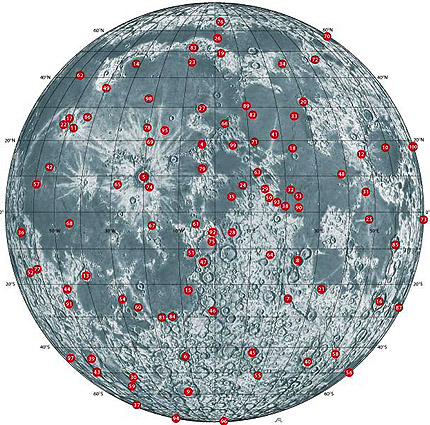Difference between revisions of "May 23, 2015"
(Created page with "__NOTOC__ =Lunar 100= Originally published May 22, 2004 <!-- Start of content --> <p align="center"> <table width="640" border="0" align="center" cellpadding="6" cellspacing=...") |
(No difference)
|
Latest revision as of 00:05, 23 May 2015
Lunar 100
Originally published May 22, 2004
Image Credit: Sky & Telescope |
|
Lunar 100 Have you heard of the Lunar 100? It is a Messier List for the Moon. A year or so ago I wondered why amateurs didn't pay more attention to the Moon, which is the largest* (angular measurement), most conspicuous and most visually complex object in the night sky. And then I realized that the very richness of detail presented by the Moon probably overwhelms many observers. You can look at a typical Messier object and in an instant (with dark adapted eyes) see most of what is visible - and the next time you look you will see nearly the same thing. The Moon is, by comparison, infinitely more interesting with thousands of features that look different every time you observe, because of changes in sun angles, libration, seeing and telescope aperture. I decided that if amateurs had a guide to interesting features with brief descriptions of why they are interesting, they could overcome the complexity and begin to explore. So I spent many pleasant hours selecting 100 lunar objects that would make both a tour and a serial education of the Moon. And since so many people are compulsive list finishers I though that making a list of 100 features would keep an observer occupied long enough to learn the Moon and hopefully become a dedicated observer! I am not sure how well my subversive scheme is working. I know that some people are commenting on various listservs about observing some of the L objects, but so far no one has claimed to have seen them all. Since the April issue of Sky & Telescope each of my monthly columns describe a few of the L100 objects. In about two years all 100 will have been described and a book will be published as a handy guide. By the way, today is my birthday (no congrats are needed - I had little to do with it other than showing up) and that is why my L100 list is LPOD today. I would like future LPODs to commemorate skilled lunar observers and theoreticians, so from time to time LPODs will feature their work. Technical Details:
Related Links: Yesterday's LPOD: Volcanic Craters on the Moon Tomorrow's LPOD: Moon Hides Venus |
Author & Editor:
Charles A. Wood
COMMENTS?
Register, Log in, and join in the comments.




